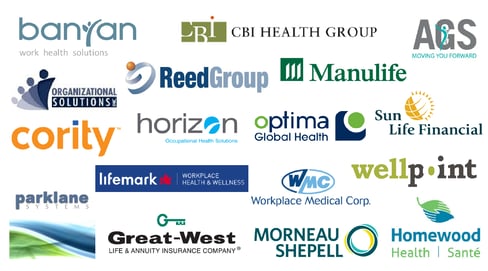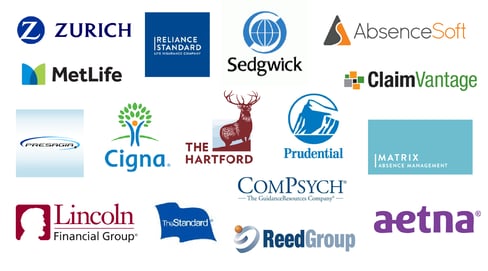Worksite wellness is disability + illness prevention that goes beyond basic disability management. Learn 10 reasons why wellness should be part of your absence management program, and how to start.
Workplace Wellness and Disability Management
Similar to our recent post about pairing Workplace Wellness and Occupational Health, this week we’re focusing on the benefits of integrating wellness with your disability management programs.
According to a 2012 AFLAC Workforce Report, employees who participate in a workplace wellness program are more satisfied at their jobs than those who don’t. Wellness, or programs that aim to prevent disability and illness, may be the component that your disability management program need.
Disability benefits are a standard offering for companies who wish to offset the cost of employees who experience long-term illness or injury, and there is no short supply of great disability management companies to work with, both in the US and Canada. Disability coverage is an easy, logical part of a complete benefits package. But while disability insurance should always be a mainstay, doesn’t it make more sense to prevent disabilities in the first place?
That’s where wellness comes in. Incorporating wellness programming to your worksite is a powerful tool for boosting the productivity, morale, and retention of employees. In the US and other countries where healthcare is privatized, it also creates savings in healthcare costs over several years. Here are 10 reasons why workplace wellness should be a part of your disability management program.
10 Reasons For Wellness
1. Prevent disability and chronic disease
The most convincing reason to offer wellness as part of your disability program is prevention. Preventable disabilities are a top cause of lost productivity in workplaces. For example, the American Diabetes Association found that people with diabetes lost 15 million days of work due to diabetes, costing the US economy approximately $2.6 billion in 2007, and that was over 10 years ago! Worksite wellness programming that focuses on education, nutrition, and exercise can decrease the number of employees who are diagnosed with diabetes and help existing diabetics manage their symptoms. The same idea applies to other preventable disabilities and chronic diseases, such as worksite injury, major depression, and more.
2. Lower health costs
Promoting healthy behavior can increase profitability. When there are fewer disabilities, injuries, and chronic diseases in your workforce, there will be fewer healthcare costs. Determining what your population needs in terms of health programming is an important first step in creating an effective wellness program to prevent and better manage disabilities. For more on this, see ‘how to get started’ below.
3. Improve productivity
A U.S. workforce study found that 70% of employees who participated in a worksite wellness program reported that productivity was an important issue for their organization, compared to just 57% of workers whose employers did not offer wellness. Additionally, among employers who offered wellness, more than half saw a decrease in absenteeism, and 66% reported increased productivity. When employees are healthier, they’re better able to engage and focus on their work. Plus, disabled employees are able to return to work faster and manage their disabilities better with a holistic approach.
4. Boost employees’ overall health
Worksite wellness consists of an organization-wide program to encourage healthy habits, change negative health behavior, and improve population health outcomes. There are number of ways to do this, including a combination of health education like lunch and learn seminars, health coaching, incentivized health screenings for early disease detection, weight loss programming, and physical activity programs and challenges.
5. Change health behavior by changing policies
Helping to change unhealthy behaviors is the first step toward enhancing quality of life for your employees. It’s easy to assume that all of the changes need to come from the employees (such as weight loss, tobacco cessation, etc). However one of the best ways to help is to change the environment and policies in your workplace. Options like flex time and a full benefits package are a staring place.
6. Encourage healthy habits with incentives – for now
Healthy habits, not just one-time actions, help employees stay healthy for the long run. It’s often necessary to start with extrinsic rewards for healthy actions, but the best wellness programs actually help employees experience the intrinsic rewards as well. For example, diabetic employees who are trying to better manage their symptoms may benefit from health incentives for participating nutrition and activity programs. But once they start to see the benefits, attention should shift to the intrinsic rewards, like losing weight, clothes fitting better, and having more energy, as the real, lasting incentives.
7. Reduce stress and depression
Anxiety and depression cost employers about $210.5B annually in the U.S. worksite wellness programs that focus on exercise, meditation, and/or mindfulness are proven to help boost mental health in the workplace and reduce work-related stress, which, if left unmanaged, can cause debilitating anxiety and depression.
8. Create a culture of health
Creating a culture of health in your workplace not only encourages healthy living practices among employees, but it can reinforce the good habits your programs instill by letting employees see each other living healthy lifestyles. This kind of positive reinforcement is great for your employees and your organization overall.
9. Build community
Have you ever been to a company ‘team building’ activity? The purpose of these kinds of exercises is to build camaraderie or community among coworkers. Improving relationships between workers helps them feel more valued, heard, and respected as an important part of the group. Fun ways to enhance community in your workplace include health competitions and challenges, philanthropic events, sharing bios and stories, and more.
10. Reduce employee turnover
All of the items listed above can help your organization be seen as a talent magnet. Companies that are enjoyable to work for, have engaged employees, managers who care, and flexible, fun health programming, are more likely to create an atmosphere that the best workers want to be a part of.
How to get started
Even businesses with modest wellness budgets can get started with a program that can reduce health risks and increase quality of life for workers. The Centers for Disease Control and Prevention advocates for this simple, 4-step model for worksite wellness implementation.
1. Workplace Health Assessment
A Health Risk Assessment (HRA) helps participants take the first step to better health. By completing the HRA, participants learn how the foods they eat, the stress they feel and the activities they do affect their health - and much more.
The main objectives of the HRA are to:
- Assess health status
- Estimate the level of health risk
- Inform and provide feedback to motivate behavior change to reduce health risks
- Address gaps in preventive care (such as the need for preventive screenings and vaccinations)
- Identify the need for referral to a healthcare provider for consideration of medication changes to optimize risk reduction
- Stratify individuals for triaging and referral to lifestyle management, condition management and other programs involving different intensities of intervention
CoreHealth offers an out-of-the-box, fully editable Lifestyle Assessment, the University of Michigan HRA and several other HRA providers that seamlessly integrate with our platform.
2. Plan the Program
Carefully plan your program based on the information collected in the HRA. Determine the focus, size, and scope of your program, including considerations about your organization’s size, environment, and geographic location. Be sure to include:
- Leadership support to serve as an advocate and role model for the program
- Identify a coordinator and wellness committee to oversee programming
- Communicate clearly and frequently, through various methods (such as email, company intranet, physical posters, and announcements in team meetings) throughout the program.
It may make sense to start small and build on your successes over time. Starting with policy changes, such as flex time so employees can exercise, or physical changes, like adding a refrigerator and starting a fresh fruit delivery so employees can store and have access to healthy food at work, are great first steps.
Once those are in place, other programming like nutrition and activity challenges, will be supported by the shifts in company culture you’ve already created. Ready-to-use wellness programming is also helpful.
3. Implement the Program
Most people think of the changes workers can make as the first step toward a healthier workforce – like quitting tobacco, losing weight, and getting appropriate health screenings. However, there are also company-level changes that can make a significant impact. The work environment itself has an influence on the health of employees. For example, are there bike racks nearby so workers can bike to work? Are there sufficient health benefits in your package? Are your company policies conducive to a healthy work culture, such as a mandate not to send work-related emails after a certain hour at night so employees can get better sleep and relax?
4. Evaluate
After the program has run a full first cycle, evaluate what went well and what will need adjustment. Then act accordingly. Offering the HRA annually is usually recommended for collecting data to track any improvements that resulted from your program’s first iteration, and to track changes over time. This is also a key to tracking the ROI of wellness. Once you have an understanding of the impact of your program, add to or adjust the program as needed.
Summary
Some Canadian disability management companies and US disability management companies already offer wellness programs and services as a complementary offering to their disability and absence management programs which is great news! At CoreHealth, we are seeing an increasing interest by organizations to eliminate the information silos and provide a more integrated approach to employee health and productivity. In fact, CoreHealth is underway with developing a new Complete Health Program (CHP) that is designed to combine various assessments and programs into one bundle in an integrated manner.
Contact us to learn more about CHP or to discover how we can help you better integrate your absence management programs with wellness to take employee well-being to the next level and gain a competitive advantage.
About CoreHealth Technologies
CoreHealth Technologies Inc. is a leading all-in-one corporate wellness platform trusted by wellness providers to power their health and wellbeing programs for 3+ million employees worldwide. At CoreHealth, we believe that developing the best employee wellness programs is all about giving providers the right code, design and access to best-in-class innovations. With the most customization, integrations and reliability of any software in its class, CoreHealth’s powerful platform lets users focus on growing great wellness companies. For more information, visit the CoreHealth website.





